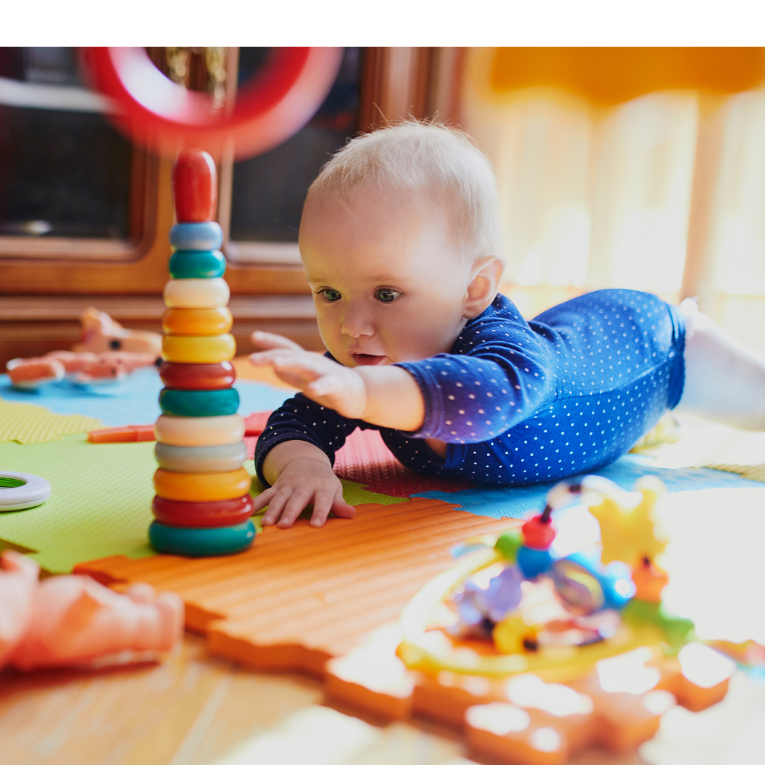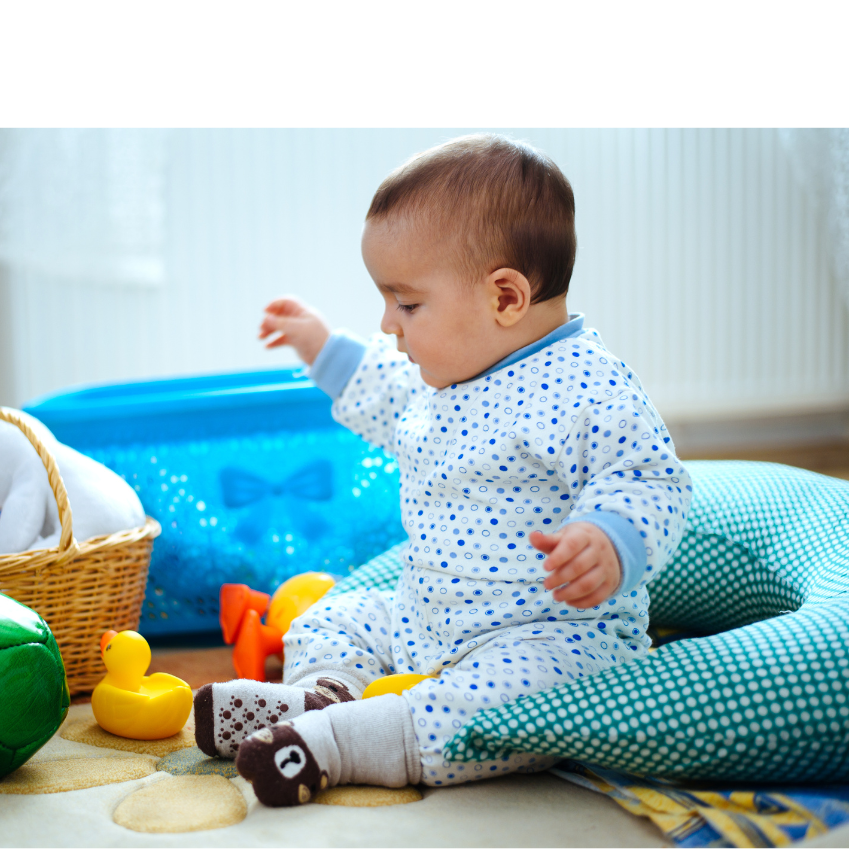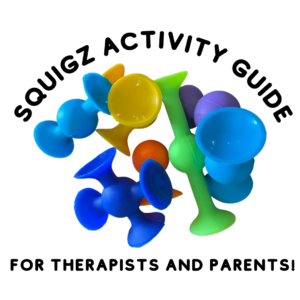Reaching is an important motor skill that develops throughout a baby’s first year, but it’s not one you immediately think about. Typically we highlight the big 4: rolling, sitting up, crawling, and walking. Reaching allows the baby to engage with their world through play, feeding, and social connection with others. It also helps develop fine motor skills/grasp, postural stability, and balance.
I teamed up with Communication Junction, a small business that hosts in-person and virtual classes to facilitate communication! We both think this skill is so important, both for fine motor development and language development! Let’s take a deeper look into how we can promote this skill through the baby’s first year!

Pre-Reaching: Tummy Time
A child needs to develop postural muscles and core strength before they are able to reach out of their base of support. How do they do this? Tummy time! It will help strengthen their neck and back muscles as well as their arms as they begin to bear weight through them.
Tummy time can be started as early as a few weeks old. Placing a child on your chest when you are laying on the couch is an ideal opportunity for them to feel the weight of gravity while working on using their neck muscles to raise their head. Use this time for skin-to-skin, which is providing the child with a rich sensory experience for their tactile system. It also allows them to regulate through the “work” by feeling your breath and heartbeat.
Tummy time can gradually transition to the floor. Using foam mats, a play gym, or a rug is the best place for a child to experience free access to floor time. When we place a blanket on the floor, it often is slippery and moves. This can get in the way of a baby’s movement. When they are on the floor, they will eventually start to push up onto their elbows and eventually hands. This provides the body with proprioceptive and tactile input, and builds muscle which enables more skilled reaching.

5 Tips for Tummy Time to be More Effective:
- Get on the floor with the child: You are your best toy. They want to hear your voice and see your face.
- Give them breaks – They don’t have to be on their tummy for 5 or 10 minutes – even a few minutes at a time is helpful
- if they start crying while laying on their tummy, don’t just pick them up from that position. Roll them to their back, so they can have more rolling opportunities.
- Use a mirror for them to look at themselves
- If the floor isn’t quite working, use a large yoga ball.
Reaching: 4 Months

Most babies will start grasping for objects during floor time around 4 months old, especially if you try to place it in their hand. Before that, their grasp is reflexive. If something touches the palm of their hand, their fingers close around it. Yup. That’s why your hair gets pulled so often. This is the very beginning of interactions with toys.
At this age, while the child is laying on their back try bringing an easy-to-grasp object to their hand. I love a good Oball or rattle. If you have a play gym, they may also begin to reach towards hanging items. The Lovevery Play Set is ideal for working on these skills and so much more. They may shake the item a few times and in the next stage will begin to use the item in more play.
Reaching: 5-6 Months

At 5-6 months the child will start to reach in tummy time. Their postural muscles have strengthened and they can begin to weight shift in order to reach for an item out in front of them. At the same time, when they are laying on their back, you’ll notice the child reaching for a toy and bringing it to their midline (the center of their body) to play with both hands. This helps to enforce bilateral coordination, midline awareness, and crossing midline. Reaching works on visual motor integration, which is how their eyes and their hands work together. As they get more skilled, they are better able to control and grade the force of their reach to successfully pick an item up.
Keep that Oball near! Because of all its open holes, it’s easy to grasp with two hands.
Reaching: 6-7 Months
At 6-7 months, when a child begins sitting up on their own, they will slowly start exploring reaching for items reach out of the base of support. As they get stronger, they are able to reach to the sides without falling over. To help support this skill, in the early stages I recommend putty a boppy behind them like shown below.

If you don’t want to use a pillow or boppy, you can use your own legs. Sit on the floor with your legs open in a V shape. Place the baby between your legs, facing away from you. Hold an object at eye level, in front of them to reach for. This will make it easier than placing an object on the floor, where they need to reach beyond their center of gravity. As they get more skilled, you can place items in front of them, and on your legs to encourage more lateral movements and trunk rotation.
Reaching: 8 Months

At about 8 months the child is more stable through their thunk and more dynamic with their reaching skills, meaning they are utilizing more mature patterns. They also have developed greater fine motor dexterity, allowing them to pick up smaller objects, like food items during mealtimes. This is also around the time when babies will reach for two items and start to bang them together. Both of these skills are so helpful for bilateral coordination and refined hand movements!
To encourage these skills, offer finger foods like cheerios or puffs so the child has the opportunity to practice picking up small objects with their fingertips. The child may begin to pick up the items using all of their fingertips to rake in the item and progress to only using their thumb and index finger. Only place a few of the cheerios down at one time. This will encourage more use of fingertips, rather than trying to grab as many as they can.
Reaching: 10-12 Months
Around 10 months, babies will start reaching across the midline of their body. For example, their right hand might pick up a block and drop it in a container on their left side. While this might not seem like a big deal, crossing midline is an important skill for many functional tasks like dressing and handwriting. It leads to greater bilateral coordination and promotes communication between the two sides of the brain.
We can encourage this skill by setting up the play environment! Actually, it doesn’t even have to be with toys this age loves helping around the house! Kids love putting things into and emptying containers. Whether it’s a laundry basket or a bucket of toys. You can strategically place items to either side of the baby to encourage them to cross midline.

Communication Junction says at this age, since they are more stable in their seated positions, they learn to reach for objects that they want or reach for people to pick them up. As babies learn that this gesture gets them what they want, reaching for an item or person becomes a way to communicate.
Once babies learn to sit, they are able to reach by raising their arms overhead to be picked up. When the caregiver sees a child using this gesture, they will typically respond with the word “UP!”, thus leading to the connection between the gesture and spoken words.
How Reaching Facilitates Communication
Gestures play an important role in your baby’s spoken language development. Gestures are one of the first building blocks to spoken language. In terms of development, it goes: Gestures → Signs → Spoken words. We look for babies to have 16 gestures by 16 months. Gestures provide babies with a way to express their wants and needs before they can talk.
Some examples of gestures include:
- Pointing to objects (typically develops between 11-13 months)
- Waving (11 months)
- Clapping (around 9 months)
- Thumbs up
If you have any concerns with your child’s developmental skills, I offer parent support sessions. These can educate you on typical motor develpment and provide you insight on how to encourage a variety of skills! You can find more info here.
Communication Junction focuses on early communication skills using signs and gestures to promote spoken language. Learn more about their programs and services at www.communicationjunction.net and follow them on Instagram!






